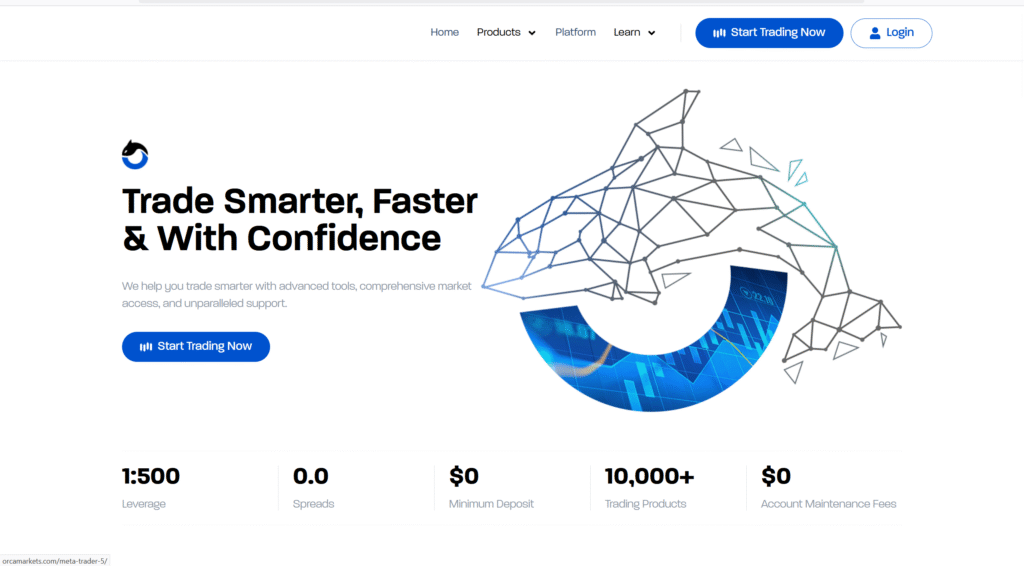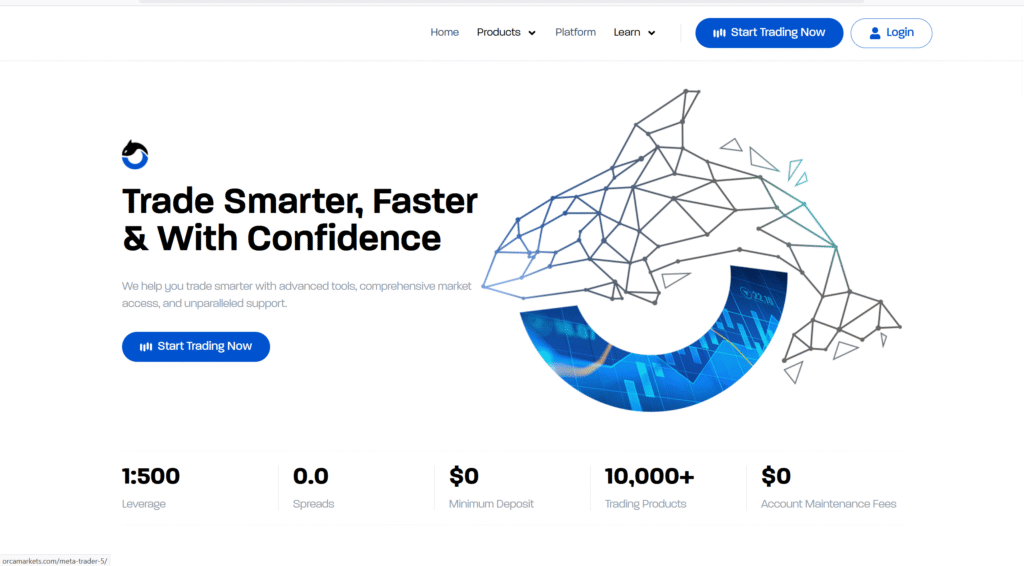Orca Markets presents itself as a polished, modern online brokerage built on the MetaTrader 5 platform, with a broad array of trading instruments, tight spreads, and high leverage. On the surface, it checks many boxes that potential investors look for: multi-asset access, automated trading tools, zero commission offers, and a slick interface. However, beneath those surface qualifications lie red flags, contradictory claims, and serious indications of risk especially when one applies a rigorous “Element 1” lens (i.e. “what are they promising/improving, how, and what are the hidden assumptions or traps?”).
Below I break down five critical warnings that emerge when you interrogate their claims, platform, reviews, and structure followed by a concluding synthesis and cautious recommendations.

1. The “Performance Enhancement” Promise vs. Invisible Constraints
Orca Markets heavily markets itself around speed, precision, and elevated performance. Their homepage highlights:
- “Lightning-fast execution”
- “Spreads from 0.0 pips”
- Multi-asset access via MetaTrader 5 (forex, commodities, indices, crypto CFDs)
- Leverage up to 1:500
- No account maintenance fees, flexible order types, deep liquidity, and “transparent pricing”
These are exactly the kinds of promises that attract active traders and those seeking quick gains. But when you look closer:
- Zero spreads from 0.0 pips is almost always a marketing lure. Brokers often attach commissions, mark-ups, or hidden fees elsewhere to recoup margins.
- High leverage (1:500) is a double-edged sword — it magnifies both profits and losses, especially in volatile markets. It increases the likelihood of margin calls or total account wipeouts for less-experienced traders.
- “Lightning execution” sounds good, but if orders are rerouted, delayed, or subject to internal matching, there’s room for slippage or manipulation not evident to the user.
- The “transparent pricing” claim must be tested in practice. Many clients report difficulties withdrawing — a classic divergence between claimed transparency and operational reality. (More on that below.)
Thus, the Element 1 dynamic promising performance enhancements to lure in investors is present here: the broker sells you on the value uplift (better spreads, speed, leverage) without immediately revealing the structural risks or hidden costs. This is a classic tactic: advertise performance upgrades, then make the “fine print” or backend execution protocols do the heavy lifting (often in the broker’s favor).
2. Regulatory Ambiguity, No Real Oversight, and Escalating Risk
One of the most alarming gaps in Orca’s structure is the lack of clear, verifiable regulation. Key observations:
- WikiFX flags Orca Markets as having “No Regulation,” calling it a high-risk operator.
- WikiFX also lists a registered address in Saint Lucia and suggests the entity is “Orca Markets Limited,” but without credible regulatory credentials.
- WikiFX’s summary: “No valid regulatory information, please be aware of the risk!”
- WikiFX also labels the broker as operating via white-label MT5 architecture, which is a red flag: it typically means that the underlying “broker backend” is shared, and the brand itself may not have robust infrastructure or independent oversight.
- In contrast, legit regulated brokers often display a clear license number (e.g. in the UK, Cyprus, or Australia), regulatory disclaimers, audits, and external oversight.
Because of this regulatory opacity, the promises of performance improvement (fast execution, “transparent” pricing) become more suspect: who monitors whether slippage or order re-routing is fair? Who ensures the broker doesn’t manipulate spreads or intervene in trades? Without a credible regulatory body overseeing them, a broker may have full discretion over internal processes to the detriment of clients.
3. Client Feedback: Withdrawal Problems & Communication Silence
A revealing window into any broker is how it handles withdrawals and support. On Trustpilot, which aggregates user reviews:
- Orca Markets has a TrustScore around 4.4 / 5 based on ~90 reviews.
- While some users praise “fast execution” and “reasonable commissions,” many raise alarms about withdrawals being blocked, ignored, or indefinitely delayed. One review states:
“I am trying to reach the Orca Markets service line to withdraw funds … have emailed twice and received no response … no one returns a call or email. TOTAL SCAM!” - Another long-time user says the platform is “excellent,” but these positive accounts tend to come from traders who haven’t yet requested large withdrawals or faced hurdles.
- The negative reviews often allege account freezes, support non-responsiveness, or excuses when users ask for money back.
This pattern good performance until the withdrawal stage — is extremely common in fraudulent brokers. The upgrade promise (fast trading, great spreads) is delivered — but the real value extraction happens when the client tries to exit. The “performance enhancement” element is exploited first to get you in, then the exit path is obstructed.
4. Breadth of Products Masks Depth of Risk
Orca Markets promotes itself as a multi-asset broker, offering a wide range of instruments:
- Forex / CFDs on currency pairs
- Indices CFDs (e.g. S&P 500, FTSE) with zero commissions and low margins
- Commodities CFDs (gold, oil, etc.) with zero commissions and real-time pricing
- Crypto CFDs for Bitcoin, Ethereum, and others
- Shares CFDs (global stocks)
Offering many asset classes is not inherently bad diversification is a legitimate strategy. But when paired with minimal oversight and performance promises, it becomes dangerous “scattergun marketing”: get as many clients as possible by offering everything, then pick and choose where to apply friction (often on volatile or illiquid pairs).
Also, while they claim “no commissions”, the pricing structure (spreads, markups, swap fees, platform fees) is not transparently audited. A client who thinks they’re trading “for free” may later find margins are loaded with hidden costs baked into pricing or trade execution.
5. Internal Conflicts, White-Label Risks, and Hidden Control Paths
Because WikiFX indicates Orca Markets is using white-label MT5 infrastructure, we need to examine how that architecture can be manipulated. White-label setups mean a central provider (or a backend broker) leases the trading infrastructure to branded “retail” entities. The risks include:
- The white-label provider may have control over liquidity provisioning, price aggregation, and order routing, which means branded brokers (like Orca) may lack independent systems or oversight.
- The profit-sharing model can incentivize manipulative practices: the broker might route client orders internally or widen spreads during high-volatility periods.
- There’s a lack of operational transparency the client sees an interface, but not the backend or how execution is handled internally.
When a firm advertises performance upgrades (faster execution, tighter spreads) while being a skin over a shared backend, it’s ambiguous whether those improvements are truly client-facing or merely cosmetic marketing.
Conclusion and Cautious Recommendations
Orca Markets positions itself as a high-performance broker using all the language of enhancement, speed, and multi-asset breadth. That’s exactly the kind of promise that fits an Element 1 pattern: “We will upgrade your trading experience; we’ll give you more.” And indeed, many users report fast execution and appealing options initially. However, closer inspection reveals structural inconsistencies:
- Lack of verifiable regulation or oversight
- Client complaints about withdrawals being blocked or ignored
- Use of white-label infrastructure
- Performance claims that are not backed by audits or third-party verification
- Broad product offerings that serve more to attract volume than to demonstrate specialized expertise
Taken together, these signs strongly suggest high risk possibly fraudulent or, at minimum, a broker that places its own interests above client protection.
If you intend to produce a public report, client advisory, or internal due-diligence memo, here’s how you can frame the findings:
- Executive Summary (200–300 words): Overview of Orca’s claims, risk profile, and your conclusions.
- Claim vs. Reality Table: List features (e.g. “0.0 pips spreads,” “fast execution”) vs. observed or reported counterpoints.
- Review & Testimonies: Use Trustpilot quotes and structural observations to highlight patterns.
- Regulatory Assessment: Show lack of license, white-label design, and address claims.
- Risk Advice & Red Flags: List concrete warnings e.g. avoid large deposits, test small withdrawals, insist on independent proof of execution, demand audit reports.
- Recommendation: Unless Orca can provide valid regulatory credentials, audited performance reports, transparent withdrawal records, we recommend against onboarding or endorsing them.
If you like, I can format this into a clean, branded PDF “Due Diligence Report on Orca Markets” for your clients or internal use (with your Vanderpool/Keystone branding). Do you want me to prepare that next?






